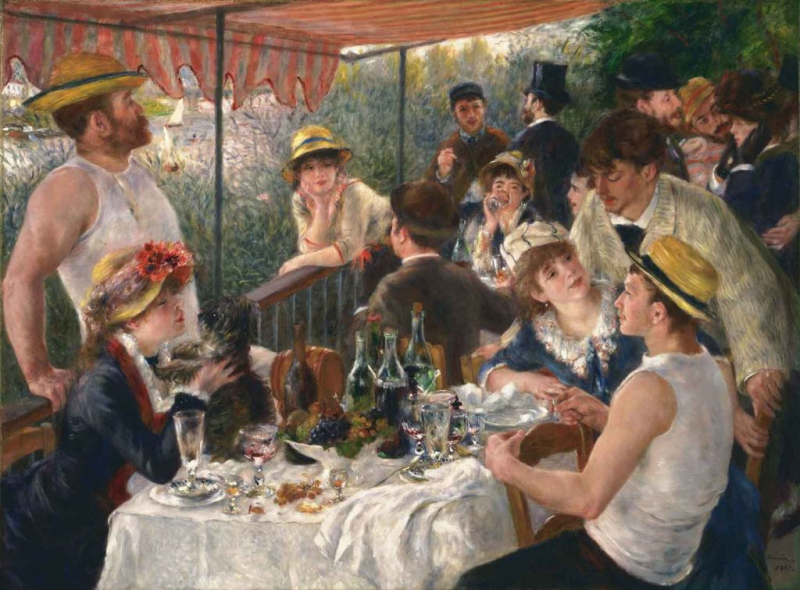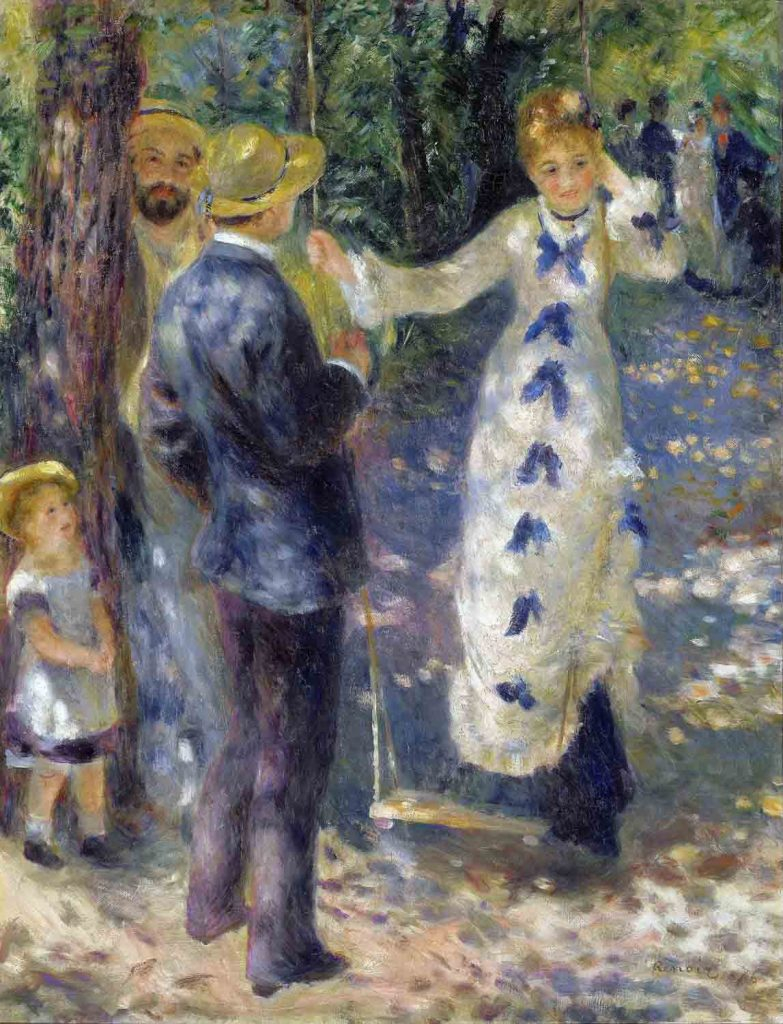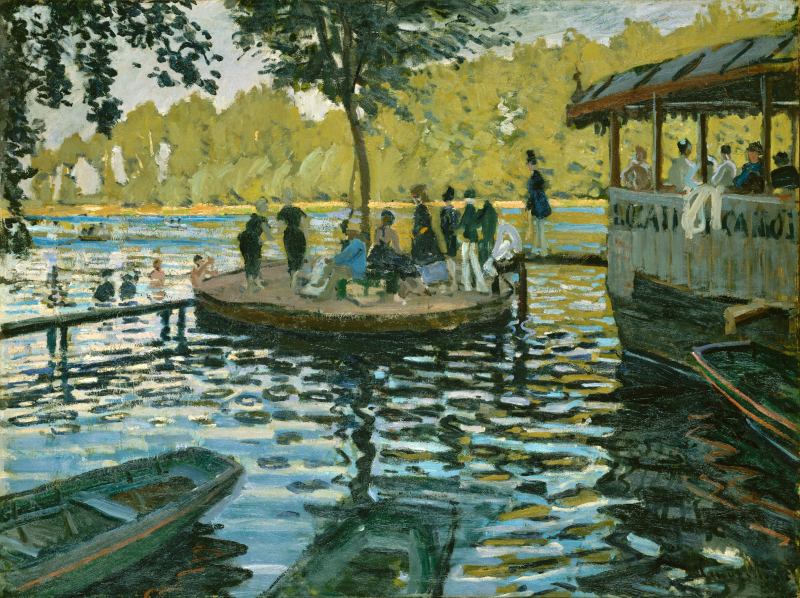Top 8 Most Famous Paintings by Pierre-Auguste Renoir
In addition to being a major character in 19th-century art, French painter Pierre-Auguste Renoir was also a key player in the Impressionist movement. He would ... read more...later carve a new route and reject the classical school of academic French painting alongside Claude Monet, Edgar Degas, and Camille Pissarro. Renoir's participation in the First Impressionist Exhibition in 1874 led to the artist's fame and increased demand. Having grown so close to the Louvre as the son of a tailor, Renoir would eventually find sanctuary in its galleries. After a while, he began taking art studies with Charles Gleyre, where he met a group of aspiring artists who quickly became close friends, Claude Monet, Alfred Sisley, and Frédéric Bazille. Even though the prestigious Paris Salon would accept some of Renoir's work, the Impressionist movement wasn't founded until after he made the decision to rebel against the system and join forces with his friends. Renoir's Impressionist works not only elevated him to the position of movement leader but also established him as one of the greatest painters of the 19th century. Renoir produced artwork that captures life in Belle Époque Paris and is renowned for his brilliant use of color and beautiful depictions of light. Let's look at Renoir's most well-known works to observe how this French master influenced the development of art.
-
This is Renoir's most renowned picture, also known as Bal du Moulin de la Galette. This artwork represents a typical Sunday afternoon at Moulin de la Galette in the Montmartre region of Paris in the nineteenth century. Moulin de la Galette was an open-air dancing venue and cafe near Renoir's home that he frequented. The painting took the artist three months to finish, during which he worked on the canvas en plein air at the café, often contending with the gusts on the Montmartre slope.
The picture depicts a scene of people having fun and socializing. Some are dancing, while others are conversing at a table. The subjects are dressed formally in gowns and suits. Even though Renoir utilizes black as the major color in this painting, he skilfully incorporates as many hues as possible into the image, and his depiction of the sunshine beams is particularly impressive. Aside from the excellent painting skills employed, this painting is notable for its depiction of leisure life in France.
The extent of the problem in painting this masterpiece was the number of people and activities that had to be depicted in order to convey the setting. Renoir demonstrates his extraordinary talent in a painting by combining collective portraiture, still life, and landscape painting. His use of color and expertise in creating a dappled light effect makes this painting emblematic of the entire Impressionist movement. The picture is also one-of-a-kind since no artist before Renoir has created an image of this grandeur to depict a regular occurrence. One of Impressionism's most recognized masterpieces, Bal du Le Moulin de la Galette, has been hailed as "the most beautiful painting of the nineteenth century."
If you wish to see it up close, it is on exhibit in the Musee d'Orsay in Paris, France.
Year: 1876
Medium: Oil on canvas
Dimensions: 131 cm × 175 cm (52 in × 69 in)
Location: Musée d'Orsay, Paris

Public domain, via Wikimedia Commons 
www.pinterest.co.kr -
This is one of Renoir's most renowned paintings, and it is one of his most famous paintings. Luncheon of the Boating Party was completed by Renoir a few years after his most renowned painting, Dance at the Moulin de la Galette.
Luncheon of the Boating Party, one of the greatest works of nineteenth-century art, blends aspects of portraiture, still life, and landscape into a single gigantic work. The painting is a romanticized representation of Renoir's companions relaxing on the Seine River at Maison Fournaise in Chatou, France. Among them are Renoir's future wife Aline Charigot and Gustave Caillebotte, another well-known Impressionist painter.
Despite the fact that Renoir has fifteen figures in the picture, including the dog, it does not appear congested or contrived like a group portrait. The picture is praised for its form richness and superb use of light, among other things. While regarded as an Impressionist masterpiece, it also employs traditional design concepts such as balance and harmony. When it was shown at the Seventh Impressionist Exhibition in 1882, Luncheon of the Boating Party was voted the greatest painting in the show by three critics. It is still a critical and popular hit.
Renoir demonstrates his amazing use of eye-catching colors in this work, which, like many of his paintings, focuses on three of his favorite subjects: still life, portraiture, and outdoor scenery.
This painting is on display at The Phillips Collection in Washington, DC, USA.Year: 1881
Medium: Oil on canvas
Dimensions: 129.9 cm × 172.7 cm (51 in × 68 in)
Location: The Phillips Collection, Washington, DC

Public domain, via Wikimedia Commons 
Pinterest -
Pierre-Auguste Renoir painted three large-scale paintings featuring two dancing partners in 1882 and 1883, the other two being La Danse à la compagne and La Danse à la city. This artwork depicts a dancing pair in Bougival, a hamlet near Paris known for its open-air cafés, which drew both locals and Impressionist painters.
"He loves everything that is cheerful, brilliant, and soothing in life," an interviewer once said of Renoir. Dance at Bougival, a picture depicting a couple waltzing and engaged in a passionate embrace, is one of his most beautiful expressions of love. The viewer can sense the dancing couple's excitement just by looking at it.
Renoir's blurring of the trees in the backdrop and the swirling shape made by the woman's garment around her feet on the canvas represent the spiraling motion of the dancers. However, our attention is drawn to the female dancer's face, which is framed by her hat, as she turns her head slightly away from her partner, who is fully charmed by her. The models for this couple were Renoir's best friends at the time, Paul-Auguste Lhote, and Suzanne Valadon.
This picture is reminiscent of Renoir's early Impressionist work in its vivid color pallet and representation of modern life. It is, however, more accurately painted, with more clearly defined outlines and intricate characteristics on its subjects in particular.When it was presented in several shows, this painting, like others by Renoir, was immediately lauded by reviewers.
The Dance at Bougival painting is currently on exhibit at the Museum of Fine Arts in Boston, Massachusetts, USA, where it is regarded as one of the finest works in the museum's collection.Year: 1883
Medium: Oil paint on canvas
Dimensions: 181.9 by 98.1 centimeters (71.6 in × 38.6 in)
Location: Museum of Fine Arts, Boston
Public domain, via Wikimedia Commons 
Flickr -
Another well-known portrait by Pierre-Auguste Renoir is Two Sisters. It shows an older girl relaxing on a patio with her younger sister. The ornate details, such as the flower crown on the small girl, the basket of flowers, and the foliage on the terrace, contrast with the subject's simplicity. Even though the background is blurred, the spectator can see the nuances of the scenery behind the subjects.
Maison Fournaise (House of Fournaise) is a restaurant in Chatou, west of Paris, set on an island in the Seine. It is the setting for not just this painting but also another classic by Renoir, Luncheon of the Boating Party. Jeanne Darlot, the painting's elder sister, went on to become an actress. The identity of the younger sister is unclear, despite the fact that she is not linked to Jeanne. Renoir gave the picture the title Two Sisters, whereas its first owner, Paul Durand-Ruel, gave it the title On the Terrace.
Annie Swan Coburn, an American art collector, paid $100,000 for the painting in 1925. It was bequeathed to the Art Institute of Chicago in 1932. It is still one of the most popular paintings in the museum today.
Year: 1881
Medium: Oil on canvas
Dimensions: 100.5 cm × 81 cm (39.6 in × 31.9 in)
Location: Art Institute of Chicago
Public domain, via Wikimedia Commons 
Chicago Tribune -
Renoir's Umbrellas is one of his most well-known works. He began working on this project in 1881 and finished it in 1986, which was remarkable because it took him five years to complete. As a result, numerous critics praised this work for its particular style, which mixes his gradual transition of style.
This painting depicts a crowded Parisian street scene, with most people wearing umbrellas to protect themselves from the rain. The Umbrellas is well-known for depicting two stages of Renoir's artistic career. It was done in two sections. Renoir began working on it in 1881, employing the quick brushwork and brilliant colors of Impressionism. He returned to painting in 1885, after losing interest in Impressionism, and found inspiration in classical art. The painting's left side, particularly the main female figure, has been painted in a more classical linear style with muted colors. The Umbrellas shows Renoir's significant contribution to the Impressionist manner of perception by introducing underlying structure. This paved the way for early Post-Impressionists like Paul Cezanne.
The picture The Umbrellas is currently on show in the National Gallery in London, UK.
Year: 1880–86
Medium: oil on canvas
Dimensions: 180.3 cm × 114.9 cm (71.0 in × 45.2 in)
Location: Hugh Lane Gallery, Dublin
Public domain, via Wikimedia Commons 
Artnet News -
Renoir made this picture the same year he created his best famous work, Dance at Le Moulin de la Galette. Renoir was renting a home in the gardens of the Musée de Montmartre in order to be close to Moulin de la Galette, an open-air dance hall, and café. During his time there, he worked on The Swing in the mornings.
Renoir was known for capturing real-life social settings, and this image is no exception. Another example of Renoir's work is in which he employs brushstrokes to highlight sunlight and shadows in a natural scene.
The painting depicts a woman on a swing conversing with a man while a young girl and another male look on. The figure in the front is French actress Jeanne Samary, who appeared in several other Renoir works, including Luncheon of the Boating Party. Renoir's brother Edmond and a painter friend named Norbert Goeneutte are the two men in the painting. The Swing was designed in the Impressionist style and displayed in the Third Impressionist Exhibition in 1877.
Year: 1876
Medium: Oil on canvas
Dimensions: 92 cm × 73 cm (36.2 in × 28.7 in)
Location: Musée d’Orsay, Paris
Public domain, via Wikimedia Commons 
Alibaba.com -
The Large Bathers captures a brief moment when a bather is poised to splash water on her buddy. Renoir's future wife Aline Charigot, the blonde sitting behind her, and the painter Suzanne Valadon, in the foreground, served as models for the painting. The gigantic painting illustrates the artist's desire to reintroduce classical aspects into modern art. The theme of the picture, as well as the sculptural representation of the people, are in keeping with 17th and 18th-century French painting tradition. In contrast to the smaller and more rapidly acquired images of Impressionism, Renoir spent three years completing this painting.
Because of the harsh criticism directed at Renoir's new manner, he never again devoted so much time and effort to a single painting. The picture is today considered one of Renoir's finest masterpieces, and it is his most renowned nude.
Pierre Auguste Renoir is well-known for representing naked ladies in his paintings, and The Large Bathers is one of the best examples. Apart from displaying naked women, this artwork drew notice due to its application of ancient styles in modern art. The Large Bathers by Renoir is on display at the Philadelphia Museum of Art in the United States.
Year: 1884 - 1887
Medium: Oil on canvas
Dimensions: 170 x 115.6 cm
Location: Philadelphia Museum of Art, USA

Public domain, via Wikimedia Commons 
Walmart -
Close friends Pierre-Auguste Renoir and Claude Monet painted several paintings showing La Grenouillère, a Seine resort where people gathered to swim, boat, socialize, and eat at its café, around 1869. Renoir and Monet were both penniless at the time, and they traded some of their paintings for food with the proprietor of La Grenouillère.
The summer of 1869 was a watershed event in art history, as the two pioneered several theories, techniques, and practices that would give rise to Impressionism. Both painters painted their interpretations of the resort from the same vantage point. Bain à la Grenouillère is Monet's version (Bath at la Grenouillere). Both painters utilized quick, exposed brushstrokes in their renditions, which experts today credit with establishing "the graphic language of classic Impressionism." However, while Monet focuses on the effects of light on the scene, Renoir's version emphasizes on the human subjects, as evidenced by the intricate hairstyles of the ladies.
This Renoir picture, which is currently housed at the Nationalmuseum in Stockholm, is quite similar to a Monet painting of the same title. Camembert (a sort of cheese) or Pot de fleurs was the name given to the small artificial island populated by tourists in both paintings (flowerpot).
Year: 1869
Medium: oil on canvas
Dimensions: 66 cm × 81 cm (26 in × 32 in)
Location: National Museum, Stockholm

Public domain, via Wikimedia Commons 
Claude Monet La Grenouillére - Wikipedia



























